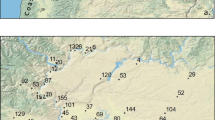Abstract
Near-surface air temperature is the most important variable in the climatic analysis of global warming. The air temperature near the surface is affected by the artificial surface (asphalt, concrete and buildings for example) surrounding the thermometer. However, there is no quantitative method for evaluating the observational environment. Therefore, a practical evaluation method with a scientific basis is required to aid observational network managers and data users. The magnitude of the artificial surface influence on the air temperature and its characteristics are investigated using numerical experiments with various road widths and wind speeds. The results show that the temperature increase in the lee of the road depends on the distance from the road, the road width, the wind speed and the thermal stratification and that the temperature increase can be estimated using an analytical footprint model. In order to estimate the largest value of the temperature increase, a function is developed from the footprint model; it depends on the normalized distance based on the road width, and thus can be calculated easily. A practical method using this function is proposed for the evaluation of the effect of the observational environment.










Similar content being viewed by others
References
Acero JA, Simon A (2010) Influence of vegetation scenarios on the local air quality of a city square. In: CLIMAQS Workshop ‘Local air quality and its interactions with vegetation’, Antwerp, Belgium, 21–22 Jan 2010
Bruse M (2009) V3.1 Online manual. http://www.envi-met.com/
Bruse M, Fleer H (1998) Simulating surface–plant–air interactions inside urban environments with a three dimensional numerical model. Environ Model Softw 13:373–384
Cleugh HA (1998) Effect of windbreaks on airflow, microclimates and crop yields. Agroforestry 41:55–84
Gash JHC (1986) A note on estimating the effect of a limited fetch on micrometeorological evaporation measurements. Bound Layer Meteorol 35:409–414
Hadfield MG (1994) Passive scalar diffusion from surface sources in the convective boundary-layer. Bound Layer Meteorol 69:417–448
Haenel HD, Grünhge L (1999) Footprint analysis: a closed analytical solution based on height-dependent profiles of wind speed and eddy viscosity. Bound Layer Meteorol 93:395–409
Horst TW, Weil JC (1992) Footprint estimation for scalar flux measurements in the atmospheric surface-layer. Bound Layer Meteorol 59:279–296
Horst TW, Weil JC (1994) How far is far enough? The fetch requirements for micrometeorological measurement of surface fluxes. J Atmos Ocean Technol 11:1018–1025
Hsieh C, Katul G, Chi T (2000) An approximate analytical model for footprint estimation of scalar fluxes in thermally stratified atmospheric flows. Adv Water Resour 23:765–772
Jacobs CJM (1994) Direct impact of atmospheric CO\(_2\) enrichment on regional transpiration. PhD Thesis, Agricultural University Wageningen, Wageningen
Jansson C, Almkvist E, Jansson P-E (2006) Heat balance of an asphalt surface: observations and physically based simulations. Meteorol Appl 13:203–212
Kumamoto M, Otstuka M, Sakai T, Hamagami T, Kawamura H, Aoshima T, Fujibe F (2013) Field experiment on the effect of a nearby asphalt road on temperature measurement. SOLA 9:56–59
Leclerc MY, Thurtell GW (1990) Footprint prediction of scalar fluxes using a Markovian analysis. Bound Layer Meteorol 52:247–258
Leclerc MY, Shen S, Lamb B (1997) Observations and large-eddy simulation modeling of footprints in the lower convective boundary layer. J Geophys Res Atmos 120(D8):9323–9334
Leroy M (2010) Siting classification for surface observing stations on land. In: Proceedings of JMA/WMO workshop on quality management in surface, climate and upper-air observations in RA II(Asia), Tokyo, Japan, 27–23 July 2010, pp 45–64
Marcolla B, Cescatti A (2005) Experimental analysis of flux footprint for varying stability conditions in an alpine meadow. Agric For Meteorol 135:291–301
Oke TR (1987) Bound Layer Clim, 2nd edn. Roultedge, Padstow
Rannik Ü, Aubinet M, Kurbanmuradov O, Sanelfeld KK, Markkanen T, Vesala T (2000) Footprint analysis for the measurements over a heterogeneous forest. Bound Layer Meteorol 97:137–166
Schmid HP (1994) Source areas for scalars and scalar fluxes. Bound Layer Meteorol 67:293–318
Schmid HP (2002) Footprint modeling for vegetation atmosphere exchange studies: a review and perspective. Agric For Meteorol 113:159–183
Schuepp PH, Leclerc MY, MacPherson JI, Desjardins RL (1990) Footprint prediction of scalar fluxes from analytical solutions of the diffusion equation. Bound Layer Meteorol 50:355–373
Stull RB (1988) An introduction to boundary layer meteorology. Kluwer, Dordrecht, 666 pp
Thomson DJ (1987) Criteria for the selection of stochastic models of particle trajectories in turbulent flow. J Fluid Mech 180:529–556
World Meteorological Organisation (1993) Siting and exposure of meteorological instruments (J. Ehinger). Instruments and observing methods Report No. 55, WMO/TD-No. 589, Geneva, 48 pp
World Meteorological Organisation (2006) Guide to meteorological instruments and methods of observation, 7th edn. Secretariat of the World Meteorological Organization, Geneva, 569 pp
World Meteorological Organisation (2010) Siting classifications for surface observing stations on land. Annex IV. Commission for Instruments and Methods of Observation 15th session, Abridged final report with resolutions and recommendations, WMO-No.1064, Geneva, 848 pp
Yamada I, Oota T, Delaunay JJ (2007) Assessment method of living environments by atmospheric environmental simulation. Paper of Environmental Planning Society 2, 1–6 (in Japanese)
Acknowledgments
The author would like to express his sincere thanks to Dr. M. Bruse. His quick answers via the ENVI-met bulletin board were very helpful to understand the ENVI-met model. Thanks are also due to Dr. S. Haginoya for his data of the soil moisture that were useful in determining the initial value for the simulations.
Author information
Authors and Affiliations
Corresponding author
Rights and permissions
About this article
Cite this article
Kinoshita, N. An Evaluation Method of the Effect of Observation Environment on Air Temperature Measurement. Boundary-Layer Meteorol 152, 91–105 (2014). https://doi.org/10.1007/s10546-014-9918-2
Received:
Accepted:
Published:
Issue Date:
DOI: https://doi.org/10.1007/s10546-014-9918-2




